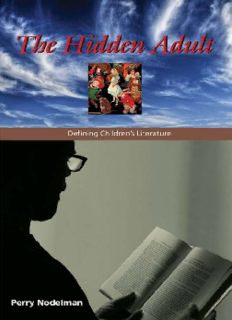
The Hidden Adult: Defining Children's Literature PDF
Preview The Hidden Adult: Defining Children's Literature
The Hidden Adult This page intentionally left blank The Hidden Adult Defining Children’s Literature S perry nodelman The Johns Hopkins University Press Baltimore ∫ 2008 The Johns Hopkins University Press All rights reserved. Published 2008 Printed in the United States of America on acid-free paper 2 4 6 8 9 7 5 3 1 The Johns Hopkins University Press 2715 North Charles Street Baltimore, Maryland 21218-4363 www.press.jhu.edu Library of Congress Cataloging-in-Publication Data Nodelman, Perry. The hidden adult : defining children’s literature / Perry Nodelman. p. cm. Includes bibliographical references and index. isbn-13: 978-0-8018-8979-0 (hardcover : alk. paper) isbn-13: 978-0-8018-8980-6 (pbk. : alk. paper) isbn-10: 0-8018-8979-0 (hardcover : alk. paper) isbn-10: 0-8018-8980-4 (pbk. : alk. paper) 1. Children’s literature—History and criticism. 2. Children—Books and reading. I. Title. z1037.a1n625 2008 028.5%5—dc22 2007049673 A catalog record for this book is available from the British Library. Special discounts are available for bulk purchases of this book. For more information, please contact Special Sales at 410-516-6936 or [email protected]. The Johns Hopkins University Press uses environmentally friendly book materials, including recycled text paper that is composed of at least 30 percent post-consumer waste, whenever possible. All of our book papers are acid-free, and our jackets and covers are printed on paper with recycled content. The little child is supposed to be pure and innocent. . . . The chil- dren alone take no part in this convention; they assert their animal nature naively enough and demonstrate persistently that they have yet to learn their ‘‘purity.’’ —Sigmund Freud, A General Introduction to Psychoanalysis In reality, childhood is deep and rich. It’s vital, mysterious, and pro- found. I remember my own childhood vividly. . . . I knew terrible things . . . but I knew I mustn’t let adults know I knew. . . . It would scare them. —Maurice Sendak, in Art Spiegelman’s In the Dumps This page intentionally left blank contents Acknowledgments ix 1 Six Texts 1 Di√erent Texts, Same Genre 1 / Language: The Text and Its Shadows 8 / Focalization: Who Sees and What They Know 18 / Desire Confronts Knowledge 33 / Home and Away: Essential Doubleness 59 / Variation 68 / Summary 76 2 Exploring Assumptions 82 Reading as an Adult 82 / Making Choices: Exploring Representative- ness 90 / Assumptions about Genre 106 / Genre and Field 117 / Genre and Genres 127 3 Children’s Literature as a Genre 133 Defining Children’s Literature 133 / No Genre 138 / Di√erent but Not Distinct 142 / Literature and Children 146 / For the Good of Children 157 / Literature for Boys and Literature for Girls 173 / Middle- Class Subjectivity 176 / Doubleness 179 / Specific Markers 188 / About Children 190 / The Eyes of Children 191 / Simplicity and Sublimation 198 / The Hidden Adult 206 / Narrator and Narra- tee 210 / Showing, Not Telling 214 / Happy Endings 216 / Achieving Utopia 222 / Binaries 227 / Repetition 232 / Variation 235 / A Comprehensive Statement? 242 4 The Genre in the Field 245 Sameness and Di√erence 245 / The Sameness of Children’s Literature 245 / Di√erent Children’s Literatures: The E√ects of Personality and History 265 / Di√erent Children’s Literatures: The E√ects of viii Contents Nationality 287 / The Genre in the Field 305 / Distinctive Texts in the Genre 315 / Conclusion: Children’s Literature as Nonadult? 338 Notes 343 Bibliography 359 Index 379 acknowledgments I thank Jayne Hildebrand for her careful work on the manuscript of this book. Jayne’s work was funded by Mavis Reimer, Canada Research Chair in the Culture of Childhood, and the Centre for Research in Young People’s Texts and Culture at the University of Winnipeg. The University of Winnipeg also supported my own work on the book by means of a number of study leaves. Leslie McGrath, head of the Osborne Collection of Early Children’s Books at the Toronto Public Library, provided me with information. My thanks also to Joe Abbott for his careful work as manuscript editor. I have been thinking about the matters I discuss in this book for some decades and have presented earlier versions of aspects of them in Children’s Literature Association Quarterly, Children’s Literature, The Lion and the Unicorn, CCL/LCJ: Canadian Children’s Literature/Littérature canadienne pour la jeunesse, CREArTA, Studies in the Literary Imagination, Children’s Literature in Education, and the Jour- nal of Children’s Literature; in my earlier books, Words about Pictures: The Narrative Art of Children’s Picture Books and, in collaboration with Mavis Reimer, the third edition of The Pleasure of Children’s Literature; in papers presented at conferences of the Children’s Literature Association, the Modern Language Association, the National Centre for Research in Children’s Literature at Reading University, and the Linguistic Circle of Manitoba and North Dakota; and in keynote addresses at conferences of the International Research Society for Children’s Literature in Stockholm, the Children’s Book Council of Australia in Canberra, the Austral- asian Children’s Literature Association for Research in Sydney, the Center for the Study of Children’s Literature at Simmons College in Boston, the conference on Modern Critical Approaches to Children’s Literature in Nashville, the Center for Børnelitteratur in Copenhagen, and the Minnesota Conference on Cultural Em- blematics at the University of Minnesota in Minneapolis. My thanks to the editors
Description: